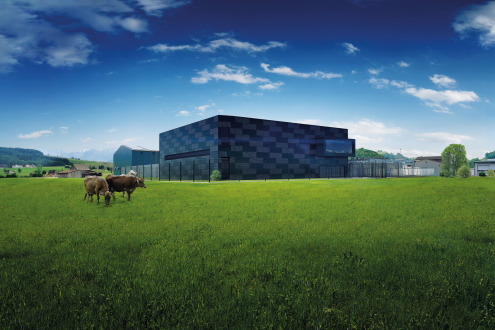No need for mechanical cooling here – and that equals energy savings!

No need for mechanical cooling here – and that equals energy savings!
The most energy-efficient data centre in Switzerland, perhaps even the whole of Europe, has taken shape in the small village of Gais. This is sustainability on a grand scale – and includes an adiabatic cooling system from Hoval.
- Data center
- New Building
Appenzellerland might be small but it still manages to do things big – not just relatively speaking but in absolute terms! SAK (full name: St. Gallisch-Appenzellische Kraftwerke AG), a power company based in St. Gallen, is currently in the process of constructing a data centre, the shell of which is already finished. On completion, it will offer maximum security, high levels of capacity and the ultimate in ecological sustainability.
This data centre – encased in 3670 m3 of concrete and 320 t of reinforcement – will ultimately house 300 server racks, which are to be split equally between the two floors measuring 450 m2 each. Customers will be able to start storing their data here from 2018. The building “is going to have a redundant design right down to each individual rack,” promises SAK. As an electricity and data service provider, the company intends to use the data centre to open up a whole extra business segment. The company’s claims are echoed by those of the regional newspaper, which reports that this will create “a safe haven for data with the highest Tier IV security level and virtually 100% availability” in Eastern Switzerland.
Energy efficiency redefined
SAK has chosen the Gais site with a great deal of care: situated at 919 metres above sea level, the location offers the ideal climate for a data centre. Free cooling with fresh intake air and adiabatic cooling are sufficient to cool the server rooms constantly without any mechanical cooling.
In Gais, the ServeCool air conditioners – a product line developed by Hoval specifically for use in data centres – do not require a chilled water system for aftercooling, thus eliminating the need for compressors. To enable adiabatic cooling, water is sprayed into the external air inside the air conditioners. This moisture absorbs the heat from the air, thereby reducing the latter’s temperature. In Gais, rainwater is collected for use in adiabatic cooling.
The cross-flow plate heat exchangers are the heart of the ServeCool air conditioners. These were developed by Hoval specifically for ServeCool. Measuring 1.20 m at the side, these are among the largest individual plates manufactured by Hoval. Their size is the key to their outstanding temperature efficiency.
In Gais, the ultra-efficient plate heat exchangers cover a total area of 1200 m2. The external air and recirculated air flow through the heat exchanger separately to prevent dust and moisture from entering the highly sensitive data centre.
Of course, the eight ServeCool air conditioners per floor do take up a fair amount of space with their crossflow plate heat exchangers, but – on the other hand – no water lines are required to dissipate the heat. Also, they are highly efficient, which is one of the main reasons why the PUE (power usage effectiveness) value stands at just 1.15, a figure that is significantly below the average of 1.5 for data centres. This measure of energy efficiency is calculated by dividing the total power input by the amount of energy consumed by the server racks.
Waste heat for cheesemaking
So what will happen to all the waste heat generated at the Gais data centre? Once again, SAK’s pioneering spirit comes to the fore here, demonstrating how technology can be combined with nature. You see, there is a cheese dairy called Bergkäserei Gais right next to the data centre and they are going to use some of the heat to pasteurise their milk. Christoph Baumgärtner from SAK, who is in charge of the Gais data centre’s construction and operation, expects 1.5 million kWh of heat to be generated. “That means we will only be able to reuse 10% of the waste heat in this way,” he adds before going on to explain that they also plan to use some of the waste heat for heating the building.
The distinctive black cube on the Gais landscape owes its colour to the photovoltaics technology, with solar panels covering the roof and all four outside walls. Solar power can be used to cover peak periods, although hydroelectric power very much remains the core business of SAK. The data centre in Gais takes sustainability very seriously indeed.
Data centres and aviation
Two scientists have come to a surprising conclusion: in a joint study, Irish academic Peter Corcoran and Swedish expert Anders S.G. Andrae claim that the amount of energy consumed by data centres worldwide is similar to that of the global aviation industry.
Christian Richter, who is in charge of data centre adiabatic cooling at Hoval, has an equally surprising statistic to add:
Compared to conventional cooling, our system achieves energy savings of approximately 70%.
